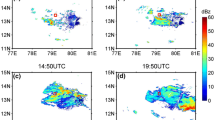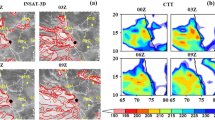Abstract
The present study is focused on examination of the physical processes of convective cell evolved from a MCS occurred on 4 November 2011 over Genoa, Italy. The Quantitative Precipitation Forecasts (QPF) have been performed using WRF v3.6 model under different configurations and cloud permitting simulations. The results indicate underestimation of the amount of precipitation and spatial displacement of the area with a peak 24-h accumulated rainfall in (mm). Our main objective in the research is to test the cloud model ability and performance in simulation of this particular case. For that purpose a set of sensitivity experiments under different model initializations and initial data have been conducted. The results also indicate that the merging process apparently alters the physical processes through low- and middle-level forcing, increasing cloud depth, and enhancing convection. The examination of the microphysical process simulated by the model indicates that dominant production terms are the accretion of rain by graupel and snow, probabilistic freezing of rain to form graupel and dry and wet growth of graupel. Experiment under WRF v3.6 model initialization has shown some advantage in simulation of the physical processes responsible for production and initiation of heavy rainfall compared to other model runs. Most of the precipitation came from ice-phase particles-via accretion processes and the graupel melting at temperature T0 ≥ 0°C. The rainfall intensity and accumulated rainfall calculated by the model closely reflect the amount of rainfall recorded. Thus, the main benefit is to better resolve convective showers or storms which, in extreme cases, can give rise to major flooding events. In such a way, this model may become major contributor to improvements in weather analysis and small-scale atmospheric predictions and early warnings of such subscale processes.
Similar content being viewed by others
References
Bedrina, T., A. Parodi, A. Quarati, and A. Clematis, 2012: ICT approaches to integrating institutional and non-institutional data services for better understanding of hydro-meteorological phenomena. Nat. Hazards Earth Syst. Sci., 12, 1961–1968.
Blamey, R. C., and C. J. C. Reason, 2009: Numerical simulation of a mesoscale convective system over the east coast of South Africa. Tellus, 61A, 17–34.
Bresson, E., V. Ducrocq, O. Nuissier, D. Ricard, and C. de Saint-Aubin, 2012: Idealized numerical simulations of quasi-stationary convective systems over the Northwestern Mediterranean complex terrain. Quart. J. Roy. Meteor. Soc., 138, 1751–1763.
Buzzi, A., S. Davolio, P. Malguzi, O. Drofa, and D. Mastrangelo, 2013: Heavy rainfall episodes over Liguria of autumn 2011: Numerical forecasting experiments. Nat. Hazards Earth Syst. Sci. Discuss., 1, 7093–7135.
Byun, U-Y., J. Hong, S.-Y. Hong, and H. H. Shin, 2015: Numerical simulation of heavy rainfall over central of Korea on 21 September 2010 using the WRF model. Adv. Atmos. Sci., 32, 855–869.
Chen, S. S., Houze, R. A., and B. E. Mapes, 1996: Multiscale variability of deep convection in relation to large-scale circulation in TOGA COARE. J. Atmos. Sci., 53, 1380–1409.
Clark, P. A., K. A. Browing, C. J. Morcrette, A. M. Blyth, R. M. Forbes, B. Brooks, and F. Perry, 2013a: The evolution of an MCS over southern England. I: Observations. Quart. J. Roy. Meteor. Sci., 140, 439–457.
Clark, P. A., K. A. Browing, R. M. Forbes, C. J. Morcrette, A. M. Blyth, and H. W. Lean, 2013b: The evolution of an MCS over southern England. II: Model simulations and sensitivity to microphysics. Quart. J. Roy. Meteor. Sci., 140, 458–479.
Coniglio, M. C, E. Harold, S. J. Brooks, S. Weiss, and F. Corfidi, 2007: Forecasting the Mainte-nance of Quasi-Linear Mesoscale Convective Systems. Wea. Forecasting, 22, 556–570.
Ćurić, M., 2000: Cloud dynamics. Belgrade University Serbia Press, 250 pp.
Ćurić, M., and D. Janc, 1995: On the sensitivity of the continuous accretion rate equation used in bulk-water parameterization schemes. Atmos. Res., 39, 313–332.
Ćurić, M., and D. Janc, 1997: On the sensitivity of hail accretion rates in numerical modeling. Tellus, 49, 100–107.
Ćurić, M., and D. Janc, 2012: Differential heating influence on hailstorm vortex pair evolution. Quart. J. Roy. Meteor. Soc., 138, 72–80.
Ćurić, M., D. Janc, and V. Vučković, 2009: The influence of merging and individual storm splitting on mesoscale convective system formation. Atmos. Res., 93, 21–29.
De Lima, E., E. L. Nascimento, and K. K. Droegemeier, 2005: Dynamic Adjustment in a Numerically Simulated Mesoscale Convective System: Impact of the Velocity Field. J. Atmos. Sci., 63, 2246–2268.
Doswell, C. A., H. E. Brooks, and R. A. Maddox, 1996: Flash flood forecasting: An ingredients-based methodology. Wea. Forecasting, 11, 560–581.
Durran, D. R., 1981: The Effects of Moisture on Mountain Lee Waves. Ph.D. Thesis, Masschussets Institute of Technology, (NTIS PB 82126621).
Goyens, C., D. Lauwaet, M. Schröder, M. Demuzere, V. Lipzig, and P. M. Nicole, 2012: Tracking mesoscale convective systems in the Sahel: relation between cloud parameters and precipitation. Int. J. Climatol., 32, 1921–1934.
Fiori, E., A. Comellas, L. Molini, N. Rebora, F. Siccardi, D. J. Gochis, S. Tanelli, and A. Parodi, 2014: Analysis and hindcast simulations of an extreme rainfall event in the Mediterranean area: The Genoa 2011 case. Atmos. Res., 138, 13–29.
Fritsch, J. M., and G. S. Forbes, 2001: Mesoscale convective systems. In Severe Convective Storms. Amer. Meteor. Soc., 323–357.
Hsie, E-Y., R. D. Farley, and R. D. Orville, 1980: Numerical simulation of ice-phase convective cloud seeding. J. Appl. Meteorol., 19, 950–977.
Houze, R. A., 1993: Cloud Dynamics. Academic Press, 573 pp.
Houze, R. A., 2004: Mesoscale convective systems. Rev. Geophys., 42, doi:10.1029/2004RG000150.
Klemp, J. B., and D. R. Durran, 1983: An upper boundary condition permitting internal gravity wave radiation in numerical mesoscale models. Mon. Wea. Rev., 111, 430–444.
Klemp, J. B., and R. B. Wilhelmson, 1978: The simulation of three-dimensional convective storm dynamics. J. Atmos. Sci., 35, 1070–1096.
Lin, Y. L., R. D. Farley, and H. D. Orville, 1983: Bulk parameterization of the snow field in a cloud model. J. Climate Appl. Meteor., 22, 1065–1092.
Marsham, J. H., and D. J. Parker, 2006: Secondary initiation of multiple bands of cumulonimbus over southern Britain. Part II. Dynamics of secondary initiation. Quart. J. Roy. Meteor. Sci., 132, 1053–1072.
Mathon, V., L. Henri, and L. Thierry, 2002: Mesoscale Convective System Rainfall in the Sahel. J. Appl. Meteor., 41, 1081–1092.
Mrowiec, A. A., C. Rio, A. M. Fridlind, A. S. Ackerman, A. S. Del Genio, O. M. Pauluis, A. C. Varble, and J. Fan, 2012: Analysis of cloudresolving simulations of a tropical mesoscale convective system observed during TWP-ICE: Vertical fluxes and draft properties in convective and stratiform regions. J. Geophys. Res., 117, D19201, doi: 10.1029/2012JD017759.
Nachamkin, J. E., and W. R. Cotton, 1999: Interactions between a Developing Mesoscale Convective System and Its Environment. Part II: Numerical Simulation. Mon. Wea. Rev., 128, 1225–1244.
Nakazawa, T., 1988: Tropical cloud clusters within intraseasonal variations over the western Pacific. J. Meteor. Soc. Japan, 66, 823–839.
Orville, H. D., and F. J. Kopp, 1977: Numerical simulation of the history of a hailstorm. J. Atmos. Sci., 34, 1596–1618.
Parodi, A., G. Boni, L. Ferraris, F. Siccardi, P. Pagliara, E. Trovatore, E. Foufoula-Georgiou, and D. Kranzlmueller, 2012: The “perfect storm”: from across the Atlantic to the hills of Genoa. EOS., 93, 225–226.
Parker, M. D., and R. H. Johnson, 2004: Structures and Dynamics of Quasi-2D Mesoscale Convective Systems. J. Atmos. Sci., 61, 545–567.
Pulvirenti, L., M. Chini, S. Marzano, N. Pierdicca, S. Mori, L. Guerriero, G. Boni, and L. Candela, 2011: Detection of floods and heavy rain using Cosmo-SkyMed data: The event in Northwestern Italy of November 2011. 2012 IEEE Int. Geosci. Remote Sens. Symp., Munich, 3026–3029.
Rebora, N., and Coauthors, 2013: Extreme Rainfall in the Mediterranean: What Can We Learn from Observations? J. ydrometeor., 14, 906–922.
Schenkman, A. D., M. Xue, and A. Shapiro, 2012: Tornadogenesis in a Simulated Mesovortex within a Mesoscale Convective System. J. Atmos. Sci., 69, 3372–3390.
Smith, P. L., G. G. Myers, and H. D. Orville, 1975: Radar reflectivity calculations on numerical cloud models using bulk parameterization of precipitation. J. Appl. Meteor., 14, 1156–1165.
Sekhon, R. S., and R. C. Srivastava, 1970: Snow size spectra and radar reflectivity. J. Atmos. Sci., 27, 299–307.
Silvestro, F., S. Gabellani, F. Giannoni, A. Parodi, N. Rebora, R. Rudari, and F. Siccardi, 2012: A hydrological analysis of the 4 November 2011 event in Genoa. Nat. Hazards Earth Syst. Sci., 12, 2743–2752.
Spiridonov, V., and M. Ćurić, 2003: Application of a cloud model in simulation of atmospheric sulfate transport and redistribution. Part I: Model description. Idojárás, 107, 85–115.
Spiridonov, V., and M. Ćurić, 2006: A three-dimensional modeling studies of hailstorm seeding. J. Wea. Mod., 38, 31–37.
Spiridonov, V., Z. Dimitrovski, and M. Ćurić, 2010: A Three-Dimensional Simulation of Supercell Convective Storm. Adv. Meteor., 2010, doi: 10.1155/2010/234731.
Telenta, B., and N. Aleksic, 1988: A three-dimensional simulation of the 17 June 1978 HIPLEX case with observed ice multiplication. 2nd International Cloud Modeling Workshop, Toulouse, WMO/TD No. 268, 277–285.
van Weverberg, K., and Coauthors, 2013: The Role of Cloud Microphysics Parameterization in the Simulation of Mesoscale Convective System Clouds and Precipitation in the Tropical Western Pacific. J. Atmos. Sci., 70, 1104–1128.
Author information
Authors and Affiliations
Corresponding author
Rights and permissions
About this article
Cite this article
Spiridonov, V., Ćurić, M. Examination of physical processes of convective cell evolved from a MCS — Using a different model initialization. Asia-Pacific J Atmos Sci 52, 263–279 (2016). https://doi.org/10.1007/s13143-015-0088-z
Received:
Accepted:
Published:
Issue Date:
DOI: https://doi.org/10.1007/s13143-015-0088-z




